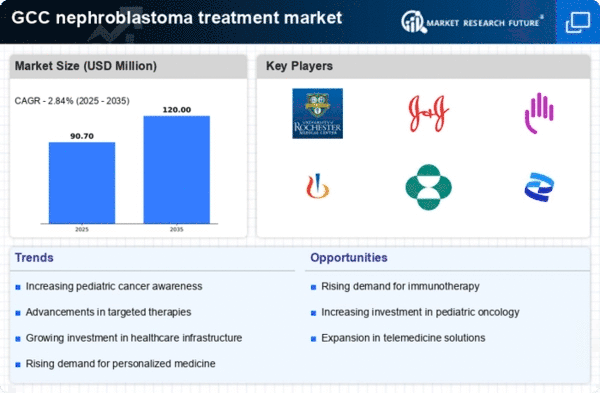Increased Awareness and Education
There is a growing awareness regarding nephroblastoma among healthcare professionals and the general public in the GCC. Educational initiatives aimed at improving knowledge about pediatric cancers are being implemented, which may lead to earlier detection and treatment of nephroblastoma. This heightened awareness is likely to drive demand for treatment options, thereby impacting the nephroblastoma treatment market positively. Additionally, support groups and advocacy organizations are playing a vital role in disseminating information, which could further enhance patient engagement and treatment adherence. As awareness continues to rise, the nephroblastoma treatment market may see an increase in patient referrals and treatment uptake.
Advancements in Medical Technology
Technological advancements play a crucial role in shaping the nephroblastoma treatment market. Innovations in imaging techniques, such as MRI and CT scans, have significantly improved the accuracy of diagnosis and staging of nephroblastoma. Furthermore, the development of minimally invasive surgical techniques has enhanced treatment efficacy while reducing recovery times for pediatric patients. The integration of artificial intelligence in treatment planning and monitoring is also emerging, potentially revolutionizing patient care. As these technologies become more accessible in the GCC region, they are likely to contribute to the growth of the nephroblastoma treatment market, ensuring that healthcare providers can offer cutting-edge solutions to their patients.
Government Initiatives and Funding
Government initiatives aimed at improving pediatric healthcare are significantly influencing the nephroblastoma treatment market. In the GCC, various health ministries are allocating funds to enhance cancer treatment facilities and research programs. This financial support is crucial for developing new therapies and improving existing treatment protocols for nephroblastoma. Furthermore, public health campaigns focused on cancer awareness and prevention are likely to increase the number of diagnosed cases, thereby expanding the patient base for treatment. As governments prioritize pediatric oncology, the nephroblastoma treatment market is expected to benefit from increased funding and resources, fostering innovation and improving patient outcomes.
Rising Incidence of Nephroblastoma
The market is experiencing growth due to the rising incidence of nephroblastoma in the GCC region. Recent data indicates that the incidence rate of this pediatric cancer has shown an upward trend, with approximately 1.5 cases per 100,000 children reported annually. This increase necessitates enhanced treatment options and healthcare resources, thereby driving demand within the nephroblastoma treatment market. As healthcare providers and policymakers recognize the need for effective interventions, investments in research and development are likely to rise, further propelling market growth. The focus on early diagnosis and improved treatment protocols is expected to enhance patient outcomes, which may lead to a more robust nephroblastoma treatment market in the coming years.
Collaboration Among Healthcare Providers
Collaboration among healthcare providers, including hospitals, research institutions, and pharmaceutical companies, is emerging as a key driver in the nephroblastoma treatment market. Such partnerships facilitate the sharing of knowledge, resources, and best practices, which can lead to improved treatment protocols and patient care. In the GCC, collaborative efforts are being made to establish comprehensive treatment guidelines and clinical trials focused on nephroblastoma. These initiatives not only enhance the quality of care but also promote the development of novel therapies. As collaboration continues to strengthen within the healthcare ecosystem, the nephroblastoma treatment market is likely to experience growth, driven by innovation and improved patient outcomes.

















Leave a Comment